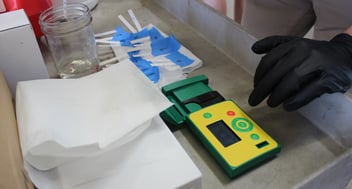
The Ultimate Guide to Disinfection and Sterilization with Hydrogen Peroxide (Part 1)
In environments where cleanliness is non-negotiable—like healthcare facilities, laboratories, and food processing plants—the processes of disinfection bio-decontamination and sterilization are critical. While often used interchangeably, these terms describe distinct methods with different purposes. Understanding the difference between these terms is key to implementing effective microbial control strategies. In this series, we’ll clarify these terms and explore how hydrogen peroxide (H2O2) has become a powerful and versatile tool in both disinfection and sterilization.
Disinfection vs. Bio-decontamination vs. Sterilization
To effectively manage microbial contamination, it’s important to differentiate between disinfection and sterilization:
Disinfection is the process of eliminating many or all pathogenic microorganisms, except for bacterial spores, on inanimate objects. It’s typically achieved through chemical means or wet pasteurization. In healthcare settings, disinfection is essential for reducing the risk of healthcare-associated infections (HAIs) by lowering the microbial load on surfaces and equipment to a safe level. This process is often used as a form of supplemental disinfection in areas where manual routine cleaning may not be sufficient or expose gaps infection control measures.
Bio-decontamination refers to the process of eliminating many or all microorganisms, including spores, on the surface of treated items. Testing for bio-decontamination generally involves verifying at least a log 6 reduction in spores.
Sterilization, is a more comprehensive process that destroys or eliminates all forms of microbial life, including resilient bacterial spores. Sterilization is typically achieved through methods such as steam under pressure, dry heat, or chemical methods like hydrogen peroxide gas plasma or liquid chemicals. This process is indispensable in healthcare settings for instruments and areas that require complete sterility, such as surgical tools and critical care environments.
While Sterilization aims for absolute sterility, some health professionals and technical literature may refer to high-level disinfection or bio-decontamination as "sterilization," leading to some confusion. In reality, when chemicals are used to destroy all forms of microbiologic life, they are termed chemical sterilants. These same germicides, when used for shorter exposure periods, serve as part of the disinfection process (i.e., high-level disinfection).
Why Choose Hydrogen Peroxide for Disinfection?
Hydrogen peroxide (H2O2) has emerged as a go-to solution for both disinfection, bio-decontamination, and sterilization, thanks to its broad-spectrum efficacy and environmentally friendly profile. But what makes H2O2 so effective?
Broad-Spectrum Efficacy: H2O2 is highly effective against a wide range of microorganisms, including bacteria, viruses, fungi, and spores. Its ability to disrupt the cell walls of these organisms makes it a powerful agent in both disinfection and sterilization processes.
Environmentally Friendly: H2O2 breaks down into water and oxygen, leaving no harmful residues behind. This makes it an eco-friendly option that doesn’t pose risks to human health after proper application.
Material Compatibility: Unlike some other disinfectants and sterilants, H2O2 is compatible with a most materials, reducing the risk of damage to sensitive equipment and surfaces during the disinfection or sterilization process.
Stable and Safe: Aqueous solutions of hydrogen peroxide (H2O2), especially those with concentrations below 8%, are safe to handle and transport. This makes H2O2 convenient and practical for use across various settings.
For optimal shelf life, these solutions should be stored at room temperature and kept away from direct sunlight.
With over 25 years of proven efficacy across multiple industries, H2O2 remains a trusted and reliable choice for ensuring thorough microbial control. Additionally, in settings that require no-touch automated room disinfection (NTD), hydrogen peroxide is a highly attractive option. NTD systems allow housekeeping and environmental services (EVS) teams to achieve comprehensive disinfection or bio-decontamination of entire rooms without manual intervention, ensuring consistency and reducing the risk of human error.
How H2O2 Works: The Science Behind Its Efficacy
The secret to hydrogen peroxide’s effectiveness lies in its chemistry. When used in disinfection and bio-decontamination, H2O2 works due to its strong oxidative properties:
Oxidative Radicals: Hydrogen peroxide produces oxidative radicals, such as hydroxyl radicals (·OH). When they come in contact with microorganisms, these radicals attack and disrupt the cell membranes and DNA of the pathogens leading to their destruction.
Role of Water and Air: When hydrogen peroxide is aerosolized or vaporized, it is distributed through the room by air movement and diffusion. The H2O2 interacts with both air and surfaces in a room, ensuring even distribution across all areas. The presence of water vapor enhances the condensation of H2O2 onto surfaces, improving its ability to reach and neutralize microorganisms, even in challenging locations such as underneath and behind objects, on vertical surfaces, and on complex structures like medical equipment, room furniture, and walls.
This combination of oxidative power and environmental interaction allows hydrogen peroxide to reach all areas of a treated space, ensuring comprehensive disinfection and sterilization.
Conclusion
Hydrogen peroxide is a highly effective and environmentally friendly option for both disinfection and bio-decontamination. Its ability to eliminate a wide range of pathogens, coupled with its safety and material compatibility, makes it an ideal choice for maintaining cleanliness and infection control in various settings. For healthcare administrators seeking options for automated disinfection or supplemental disinfection through no-touch systems, hydrogen peroxide offers an efficient, reliable, and eco-friendly solution.
In our next post, we’ll delve deeper into the different methods of applying hydrogen peroxide—specifically, aerosolized versus vaporized forms—and explore the advanced technologies that enhance these processes.
---
Curious about how hydrogen peroxide can elevate your disinfection protocol? Reach out to Build With Robots for a personalized consultation and discover how no-touch automated room disinfection can seamlessly integrate into your facility’s SOPs.
Learn more:
What Is Hydrogen Peroxide Fogging and How Effective Is It?
What are the Differences & Similarities Between H2O2 & HOCl for Disinfecting a Cleanroom Surface?
Subscribe to Our Newsletter for More




